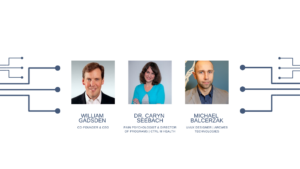Today, we’ll be discussing the ethics of digital products with Research Director and Consultant, Dr. Faye Miller. How can innovation take place with consumers in mind and what does an ethical supply chain look like in the digital space? Learn how professionals like Faye Miller’s are pushing the function forward for an ethical future in technology.


Kurt Schiller [00:00:01]: Hello and welcome to Product Hacker, a podcast about building digital products. Each month we discuss product strategy, design and development with experts and practitioners from every part of the product lifecycle. I’m your host, Kurt Schiller. Product Hacker is brought to you by Arcweb Technologies, we help companies solve their toughest business challenges through technology, consulting, experience design, and custom software development. Learn more at Arcwebtech.com.
Kurt Schiller [00:00:27]: If you’re in Philadelphia and work in healthcare, make sure to check out our “Healthcare Experience Engineers” Meetup. We feature guests and speakers who dig into the inner workings of designing healthcare experiences from a patient-centered perspective. For more information, search for “Healthcare Experience Engineers” on Meetup.
Kurt Schiller [00:00:49]: It’s been a tough twelve months for the road of business ethics. And the use and abuse of digital products has been at the forefront. From hostile design and privacy breaches to basic corporate responsibility, people are taking a closer look at the ethical ramifications of an increasingly digital world. And they’re not liking what they’re finding. It’s high time companies started paying attention too. But are they up to the challenge? With so much focus on explosive growth at all costs? Ethics has become a side hustle prized more for its role in branding and PR than for the impact it actually has on products. Even Google, a company that once claimed “Do no evil” as its unofficial tagline, seems to have settled for something closer to “Do some evil, but maybe take it easy”.
Kurt Schiller [00:01:28]: To help us navigate this tricky topic, we’re going to be joined by Dr. Faye Miller, a researcher and lecturer in information management at the University of Canberra, Australia. She’s also founding director of a digital consultancy, HumanConstellation.org.
Kurt Schiller [00:01:41]: Dr. Miller, welcome to the show.
Faye Miller [00:01:42]: Thanks for having me on the show.
Kurt Schiller [00:01:44]: So you’re really the first person that we’ve had on who comes from more of a research background as opposed to a current business background. Before we get into the topic of ethics in particular, could you give our listeners some context on your background and what you work on?
Faye Miller [00:01:56]: So I’m a social researcher and lecturer in information and knowledge management. And I’m currently based at the University of Canberra in Australia’s capital city. My work takes me pretty much worldwide through research, consulting with various organizations, and I spend some time writing and hanging out in Silicon Valley, California every year. So I mainly do research and publish in the subject areas of social, humane and ethical aspects of technologies and more broadly, how people experience information, data and knowledge within a range of environments, including technologies integrated into our daily lives.
Faye Miller [00:02:34]: After for my PhD, I developed a knowledge ecosystems model for transdisciplinary research, which is now being used to support and design, collaboration and communication across communities with diverse and sometimes opposing viewpoints such as government policy, public, nonprofit and private sectors. I use a range of qualitative methods such as grounded theory, ethnography and audiovisual methods such as documentary filmmaking to gain a deeper understanding and increased empathy for the diverse human experiences associated with technologies. And I use these methods because I believe that qualitative methodologies allow us to explore insights into the underlying reasons, attitudes and motivations within individuals, cultures and communities.
Faye Miller [00:03:25]: And perhaps the best way to facilitate designing more sustainable and ethical products and innovative solutions for problems within sectors such as social media, business, entertainment, education, health and also in everyday life.
Kurt Schiller [00:03:40]: Awesome. So ethics has been a big topic in the business world for decades, obviously, but it seems like it’s really only very recently become a major topic in the digital world. Why are people suddenly taking notice now?
Faye Miller [00:03:52]: For the past several years, ethical design has been rising as a key solution to a growing problem, which is how to ensure that the digital technologies and interactive platforms which most of the world is now so dependent on for everyday life assistance. How do they remain humane and sustainable now and in the future?
Faye Miller [00:04:14]: So some of the biggest areas of ethical concern from the public perspective are privacy, anonymity, consent, data-sharing and storage, online safety, user etiquette in communicating, and misinformation. And this year alone, we’ve heard several cases involving all of these concerns circulating in the media. Cambridge Analytica, rapid developments in machine learning and artificial intelligence. Such as the benefits and dangers of self-driving cars. These are pushing the subject of ethical behavior as intact to the front of both social and political debates. And currently we’ve identified many more problems and we have solutions.
Faye Miller [00:04:54]: So it’s really good to see that the general public are becoming extremely concerned about where our personal data collected from these sites will end up and how it’s being used to potentially manipulate our decisions and vetting our sources of information on social media and the web. But unfortunately for some people, the terrifying uncertainty and panic around these issues has caused them to stop using the technologies altogether. And this is a shame because as we know, there are a ton of positives about technology as powerful tools for innovation and social change to benefit humankind.
Faye Miller [00:05:28]: And this is why ethical design has become so important. So plus, recent research suggests that millennials, the generation born between 1976 and 2004, are a driving force behind this change as they show a preference for consuming products from ethical brands and companies. And they also believe ethical companies can outperform companies who are not as socially responsible. So there’s been recent discussion on new business models emerging that are taking into account that online consumer habits are shifting to place much more value on ethical, sustainable and socially responsible companies and brands. And these online consumers are more likely to spend money on their products and services.
Kurt Schiller [00:06:08]: Gotcha. So how does the concept of ethical design fit into the larger disciplines of design and user experience?
Faye Miller [00:06:16]: Ethical design is about respecting and maintaining human rights, human effort and human experience. So a major challenge that exists within ethical design is. How do we develop user-centered frameworks for technology-based organizations which focus more strategically on the design of the technologies, the products themselves. At the moment, ethical design is focused more on the professional ethics of the people who designed the technologies. And while professional ethical code for designers and developers operating within companies is obviously a very important part of this outcome, researchers and practitioners who focus on promoting socially responsible technology advice that we have a long way to go with translating and putting into practice that ideal across to ethical principles policies and work processes towards developing technology products and services that attract new users and support user communities actual needs, including the needs of potentially vulnerable users.
Kurt Schiller [00:07:18]: So you alluded to it earlier yourself, but many of the big discussions in ethical design right now seem to be centering around social media. Is there something specific about social media that’s making it such a thorny or such a relevant area for a design ethics?
Faye Miller [00:07:33]: Yeah, totally. It’s a great question. We all know that most social media giants like Facebook, Twitter, Instagram are all profit and shareholder driven. I think it remains a contentious area because of the apparent tension or conflict between the need to promote digital ethics from a user-centered design viewpoint and the business need for social media companies to remain profitable. So here, user-centered design ethics can be at odds with corporate ethics or a particular business model. So we can’t look at these problems from just the user communities or just the business perspective alone. We need to look at both sides of the coin and develop a middle ground where we can meet both of these needs.
Kurt Schiller [00:08:15]: So pivoting more towards tactics, I guess, in our pre-show discussion, you introduced notion that was new to me, which is that of dialogue-mapping. Could you give us a quick rundown of what it is and how it might apply to ethical concerns and design?
Faye Miller [00:08:28]: Sure. So one way of realizing ethical technology design is through a tool called dialogue mapping, developed by Jeff Conklin in his book “Dialogue Mapping: Building Shared Understanding of Wicked Problems”. So dialogue mapping is about using textual and visual information to capture and communicate the full range of human experiences, ideas, voices, journeys and positions around the development of a particular social issue or the development of a product or service. Dialogue mapping works towards actualizing the ideal notion of shared understanding, not necessarily shared agreement, but shared understanding which can give everyone involved a clearer, more balanced view of a complex or wicked problem between all stakeholders involved, say, within a particular company, or when exploring broader social issues from the perspectives of a variety of people or individuals all located across different groups, contexts or geographical locations.
Building a digital product?
Faye Miller [00:09:30]: So in practice, dialogue mapping is facilitated by specialists in transdisciplinary information, mediation and communication. So these are people who are trained to catalyze conversations and also capture what arises from collaborative synergies or conflicts within those conversations. So not just one-way expression of information, but two-way or multi-directional communication. They also visualize or draw maps during conversations depicting and analyzing dialogic data developed into a range of ideas and experiences offered by small or larger groups of people in participatory meetings, either face-to-face in real-time or in just virtual distributed networks. So while concept mapping is a commonly used technique for brainstorming sessions, dialogue mapping takes it that step further as a way to openly acknowledge all of the diverse views around a conundrum or issue and to curate or preserve the more personal and diverse aspects of the journeys of developing a product.
Faye Miller [00:10:33]: So through the participatory experience of dialogue mapping, everyone involved can ideally gain a broader and more informed insight into existing problems and therefore make informed decisions that take into account the whole picture comprised of different perspectives and backgrounds rather than just internal viewpoints within the company.
Faye Miller [00:10:54]: For example, I recently completed a project in collaboration with colleagues at the Digital Life Lab at the University of Southern Queensland, Australia, in association with Harvard University’s Berkman Klein Center on how people experience information in everyday life use of Twitter. So this project presents a textual mapping of dialogs and themes which emerge from conversational-style interviews with various people living in Boston who regularly use Twitter.
Faye Miller [00:11:26]: The research uncovered a variety of human experiences and voices, both positive and negative, within that specific social media space, which can be used to create a shared understanding of what Twitter actually means to its users on a street level as opposed to its internal corporate process. As there have been many examples in the media, like the multiple meanings of Twitter verification or the blue tick icon, where there is often a confusing disconnect between the product designer intent such as preventing identity theft and how it is interpreted by the product’s user, such as public outrage over the company’s apparent endorsement of a controversial public figure or hate speech.
Faye Miller [00:12:04]: So a technique like dialogue mapping can be useful here to help clarify these ambiguities and also identify and anticipate where and also why there may be a disconnect between the tech company or a designer and the user’s interpretations. So dialogue mapping would enable meetings where everyone can see a fully informed picture of the reasoning for a decision-making process behind a particular element of the product. By mapping dialogs within social media experiences, particularly how ubiquitous forms of data and information are experienced while using or choosing not to use these products, we can work towards transparently reconciling these disconnects or gaps in knowledge between public users, all their stakeholders and the companies themselves.
Kurt Schiller [00:12:53]: So I think your example of the blue tic with Twitter was particularly illuminating. But I think it might help listeners to kind of get a better handle on the idea of dialogue mapping. If we could walk through a real quick hypothetical scenario. So let’s say that a product team has discovered that the design of our applications opt-in processes may be coaxing people to give up more personal information than they might otherwise or maybe should be comfortable with. How would we use dialogue mapping to explore that idea?
Faye Miller [00:13:22]: OK, so we’re discovering that this particular process is compromising people’s personal information and many users are angry about where their personal information is going and thus losing trust in the product and have perhaps stopped using the product altogether to boycott our company, which we really don’t want to happen. And if it came to that, it would probably be best to rethink the design of the opt-in process so that users could have more transparency and control over privacy concerns and where their data ends up. So to avoid this outcome, dialogue mapping ideally should be used before and during the design and implementation stages of a new function or element. Dialogue mapping could be used by a product team leader or an outside consultant to enable a shared stakeholder conversation, perhaps with a selection of stakeholder representatives sitting in the same room recording answers on a whiteboard around the issue. So kicked off by these questions for product designers and developers. What is our opt-in process asking users to do for the company? Why do we need an opt-in process? What are the business or environmental reasons and for the user community? How does our opt-in process experience make you feel? What does it mean to you?
Faye Miller [00:14:44]: Of course the conversation would continue beyond that single meeting and the facilitator would monitor and capture any changes to these initial answers and integrate these into the dialogue map. So the range of answers from various stakeholders should reveal and make transparent these deeper insights we wouldn’t normally have access to. If designers and the businesses were implementing designs without first consulting using this more participatory method. And then we could capture the range of perspectives and perhaps make a decision to include an opt-out function and further information for the users about privacy informed by empathy from the personal understandings gained from the holistic picture of more nuanced views and journeys around this function combined in a dialogue map.
Faye Miller [00:15:33]: So to sum up, so a dialogue mapping builds contextualized and shared understanding, which would help maintain trusting relations between all stakeholders and even in the event of an unplanned security breach, for instance, that trust could be more easily repaired because the company has shown their care and concern for the users privacy in the first place. So the dialogue map itself could be shared online and also serves as a physical proof that the company is actively listening and listening is probably in short supply these days.
Kurt Schiller [00:16:04]: That’s really interesting. So last question you alluded earlier to the conflict between the business goals of an organization or a product and then the user needs.
Kurt Schiller [00:16:16]: And I do think that one of the biggest challenges for making a case for something like ethical design is justifying it from a business standpoint. But I think that most designers and product developers probably want to be doing work that holds up ethically. Do you think there is a business case for adopting new tools and techniques that are designed to help solve these ethical conundrums?
Faye Miller [00:16:36]: Yes, I think the business case involves advocating for a new business model called stakeholder-centered management. So to give you a bit of background, in 2016, the Harvard Business School published a book called “Conscious Capitalism: Unleashing of the Heroic Spirit of Business“. And it was by the co-CEOs of Whole Foods Market John Mackey and Raj Sidodia. Stakeholder-centered management centered on how companies related to the stakeholder and how successful they became in terms of profitability and business ethics is around the balanced and transparent relationships between the stakeholders and the shareholders. So stakeholder-centered management businesses are those that build trust with their customer. And this trust brings rewards in terms of not just profitability, but also attracts those who are willing to invest in this way of working, both in terms of their time as well as their money.
Faye Miller [00:17:34]: Their products and services are safe and to be relied upon. And the key stakeholders are not just the consumer, the supplier or the investor and the staff, but also the environment and the local community. The business impacts on. So the justification would be if tech companies don’t invest resources, time and effort into adopting new tools and techniques to respond to these ethical challenges in the long term, it could damage their brands and the trust that current consumers of social media, such as millennials or digital natives place in their products. So in terms of long term cultural change, it’s now recognized by digital ethicists working in social media context that much of this problem stems from Silicon Valley’s internal staff cultures for progress sake and move fast and break things.
Faye Miller [00:18:29]: So we need to develop ethical and sustainable frameworks for tech companies which generate shared understandings between all stakeholders, including those using and those who may be affected by their products and services. There is a need for human roles such as dialogue mapping facilitators within tech companies to constantly monitor and respond to emerging popular meanings around their products from every stakeholder’s perspective. So in this way, ethical tech design using dialogue mapping as a tool could over time prevent harmful consequences on people, organizations and tech-dependent societies.
Kurt Schiller [00:19:08]: Awesome. Well, this has been super enlightening. Thanks so much for coming on the show, Dr. Miller.
Faye Miller [00:19:12]: Thank you.
Kurt Schiller [00:19:14]: Thanks for listening to Product Hacker. Join us next time when we’ll be talking about AI, machine learning, and personalization with Brian O’Neill, Chief Technology Officer of Monetate. Product Hacker is brought to you by Arcweb Technologies, a digital design and development firm in Old City, Philadelphia.
Kurt Schiller [00:19:29]: To learn more, visit Arcwebtech.com. The show is hosted by Kurt Schiller and produced by Martin R. Schneider. As always, thanks for listening. And don’t forget to like and subscribe.



